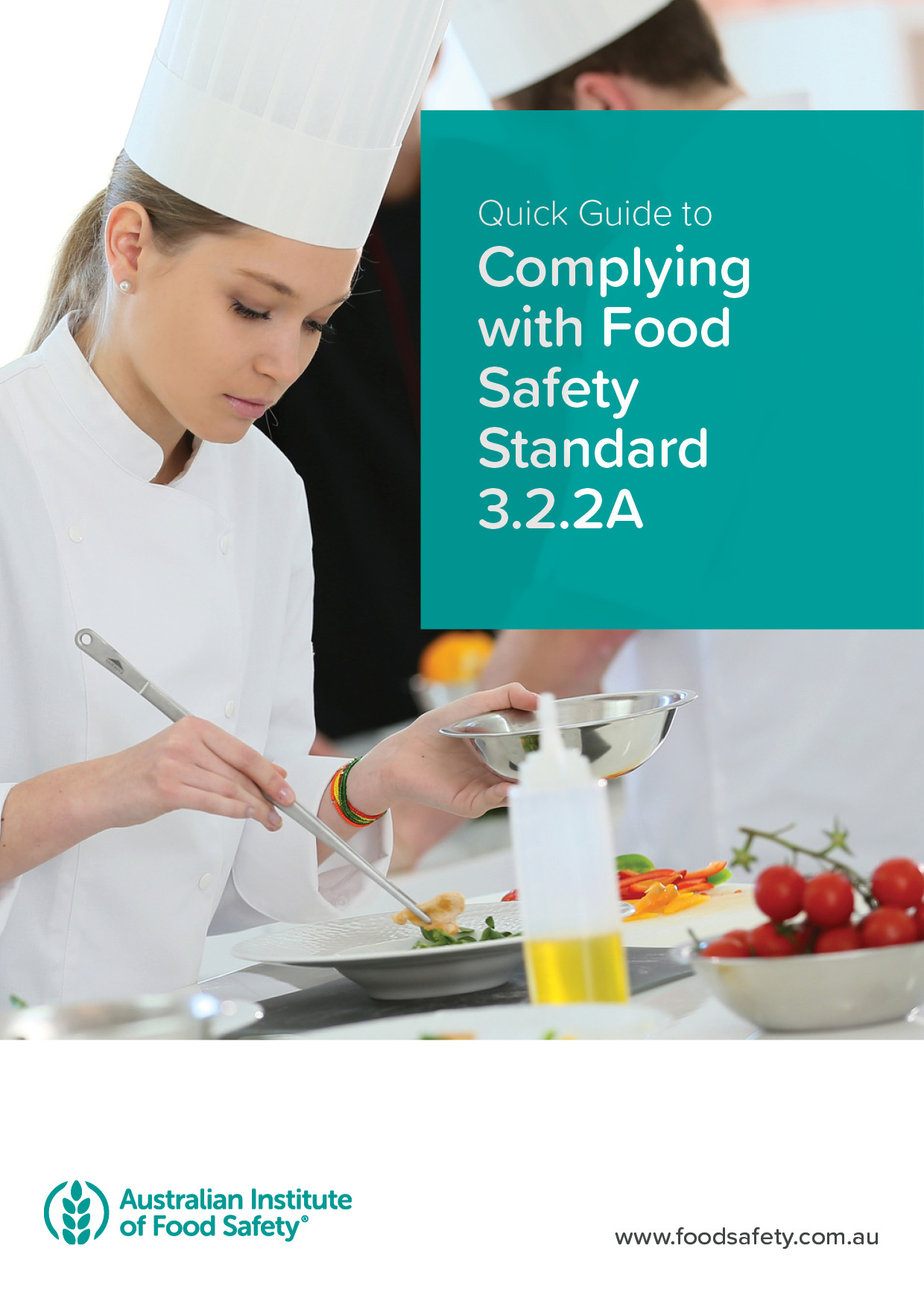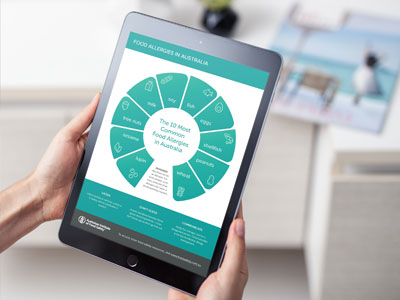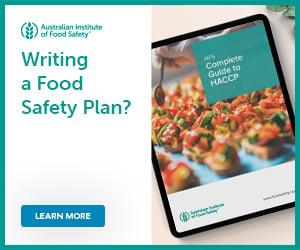
Food safety training requirements now fall under federal legislation with the introduction of FSANZ Standard 3.2.2A. Enforcement begins in December 2023 and food service businesses across Australia all need to comply.
In this guide we’ll step you through what you need to know about the new standard.
What is Standard 3.2.2A?
Standard 3.2.2A is a recent addition to the Australia New Zealand Food Standards Code. This change means that from December 2023, new requirements will be enforced for food businesses across all Australian states & territories.
If your business prepares and serves food then this change affects you.
The new requirements need to be met by any business that prepares or serves food in any Australian state and territory. Standard 3.2.2A outlines the need for a food safety management system within a business, by introducing the following three tools:
- Food Handler Training
- Food Safety Supervision
- Record Management
The specific tools that a business needs to implement is determined by the category of business.
Prior to recent changes, many states and territories (including New South Wales, Victoria, Queensland and the Australian Capital Territory) had their own special requirements for food handling and record keeping.
From December 2023 all Australian states and territories must comply with the requirements outlined in Standard 3.2.2A.
This also means that, for the first time, those states and territories that previously had limited requirements must now follow the new standard. This includes Western Australia, South Australia, Tasmania and the Northern Territory.
Understanding Standard 3.2.2A Categories
Under Standard 3.2.2A, businesses fall under category one or category two.
CATEGORY ONE BUSINESSES
A category one business refers to catering or food service operations that handle unpackaged, potentially hazardous food to make it ready for immediate consumption.
Following preparation, these dishes are served directly to consumers. Due to the direct handling of high-
risk food, there is a risk of contamination by harmful microorganisms or other hazardous elements before the food reaches the consumer.
Examples of category one businesses are:
- A dine-in restaurant that makes and serves salads and cooked meats on-site.
- A bakery that produces and sells items like custard tarts and quiches for on-site and off-site consumption.
- A takeaway shop that cooks and offers hot chicken, salads, and other fast foods for off-site eating.
- A caterer that prepares sandwich platters in a central kitchen for delivery to offices and events.
- A training centre that includes buffet meals in their training fees, cooking and serving them to participants on-site.
- Hospitals, childcare centres, and aged care facilities that prepare and serve meals to their residents or guests.
Category one businesses need to have three key food safety tools in place: an appointed Food Safety Supervisor, mandatory skills and knowledge for Food Handlers, and detailed records must be made and kept on hand for at least three months. The purpose of records is to show that the food handled by your business is safe.
CATEGORY TWO BUSINESSES
In the context of this Standard, a category two business refers to a food establishment that retails food which is both potentially hazardous and ready-to-eat. This food either arrives at the business unpackaged or is unpacked by the business after receiving it. Moreover, the business does not create or process this food, except for activities such as slicing, weighing, repacking, reheating, or hot- holding.
Examples of category two businesses include:
- A supermarket deli that unpackages bulk-bought salads, displays them chilled, and portions them for customers. The salads are ready-to-eat and potentially hazardous but not prepared on-site.
- A service station that heats and serves unpackaged pies and pastries from a local bakery. If these items were sold in their original packaging, the station would be exempt from certain standards.
As with category one businesses, those under category two need properly trained Food Handlers and at least one appointed and readily available Food Safety Supervisor. The difference is that category two businesses do not need to maintain specific records to comply with this new standard. They may, however, need to keep records under their state or territory law.
STATE OR TERRITORY CATEGORIES
Standard 3.2.2A divides businesses that serve or sell food into two categories - known as category one or category two. You need to abide by the regulations in Standard 3.2.2A according to the category your business belongs to.
However, many states and territories also have their own classification system and state or territory laws that must be adhered to. So your business may be category one under Standard 3.2.2A but category three under state legislation, and you must know and adhere to both.
It’s hoped that state, territory and federal categories will be aligned and streamlined in the future, but there are currently no announcements about this at a state or federal level.
Food Safety Supervisor Training
Every business that serves food must have at least one Food Safety Supervisor for each premises. The Food Safety Supervisor must have been certified within the last 5 years.
INDUSTRY REQUIREMENTS
Food Safety Supervisor training is industry-specific and applies to the following industries:
- Hospitality
- Health & Community
- Retail
- Food Processing
- Training & Distribution
STATEMENT OF ATTAINMENT
At the end of the training, the Food Safety Supervisor receives a Statement of Attainment with specific units of competency for their industry.
As per the new regulations, the date on the Statement of Attainment must be within the last 5 years, which means that many former Food Safety Supervisors need to re-do their training.
COURSE DURATION & FORMAT
Most people complete the Australian Institute of Food Safety course within 6 to 8 hours. The course consists of online lessons, quizzes and case studies. There is a practical component to the course: learners must request someone they work with to complete a form confirming that the learner has been observed performing certain activities in the workplace.
NSW-SPECIFIC TRAINING
Food Safety Supervisor training is nationally recognised. However, New South Wales has slightly different rules.
Food Safety Supervisors working in New South Wales must undergo training with a nominated provider, such as the Australian Institute of Food Safety, which is approved to issue certificates on behalf of the New South Wales Food Authority.
WHY AIFS?
The Australian Institute of Food Safety is approved to deliver Food Safety Supervisor training for all industries in all states and territories of Australia, including New South Wales. All courses have been updated to fully comply with the requirements of Standard 3.2.2A.
Over 98% of students would recommend the course to others, and it’s not unusual for our learners to start and complete the course in the same day.
Food Handler Training
Under Standard 3.2.2A, Food Handler training requirements have become a lot more stringent. There are specific topics that must be covered that weren’t previously included in traditional Food Handler training, such as allergen management.
Anyone that handles food in any capacity in a food business must be trained as a Food Handler and learn topics such as safe food handling techniques, ways to prevent food contamination, protocols for cleaning and sanitising food areas and equipment and best practices for personal hygiene.
INDUSTRY REQUIREMENTS
Food Handler training is industry-specific and applies to the following industries:
- Hospitality
- Health & Community
- Food Processing
STATEMENT OF ATTAINMENT
At the end of the training, the Food Handler receives a Statement of Attainment with specific units of competency for their industry.
There are no formal renewal requirements for training at the moment. However, during health inspections, Environmental Health Officers will be checking that Food Handlers have the required skills and knowledge. Refresher training will help your team be prepared for this.
COURSE DURATION & FORMAT
Most people complete the Australian Institute of Food Safety course within 3 to 4 hours. The course consists of online lessons, quizzes and case studies. There is a practical component to the course: learners must request someone they work with to complete a form confirming that the learner has been observed performing certain activities in the workplace.
WHY AIFS?
The Australian Institute of Food Safety is approved to deliver Food Handler training for all industries in all states and territories of Australia. Our Food Handler course has been adapted to encompass all requirements of Standard 3.2.2A as well as the topics already covered by the nationally recognised unit of competency.
Over 98% of students would recommend AIFS courses to others, and it’s not unusual for our learners to start and complete the course in the same day.
Record Keeping Requirements
In Standard 3.2.2A, “prescribed activities” are the handling and management of unpackaged, potentially hazardous foods. These activities involve either the preparation of such foods for meals that are immediately ready for consumption, or their retail sale in a state that’s ready to eat. For food businesses that must keep records under the new standard, the records are made to document any prescribed activities.
Documentation that validates various concerns—for example, to confirm that potentially hazardous food is maintained at safe temperatures—should be generated daily when the business is involved in prescribed activities. Each entry should specify the date, and if relevant, the time it was recorded, along with a description of the food or activity.
HOW IS A RECORD DEFINED?
Under the new Food Safety Standard 3.2.2A, a record is defined as any documented information that can provide evidence of compliance with the Food Safety Program. Records can range from written logs to digital files, and according to Standard 3.2.2A they must include but are not limited to:
- Temperature monitoring logs for storage units and cooking equipment
- Cleaning and sanitation schedules
- Records of raw materials, including supplier details
- Employee training documentation
- Customer complaints and incident reports
- Notes on invoices (e.g. a receipt temperature)
- Photos or video footage
- Written instructions that have been verified to archive food safety outcomes
One record can cover multiple prescribed activities, for example, documenting the temperature of a cool room that stores various types of potentially hazardous food. The key aspect is that these records must be accurate, easily accessible, and interpretable. They should be available for internal reviews and external audits to ascertain the effectiveness of the Food Safety Program.
DURATION OF RECORD KEEPING
According to Standard 3.2.2A, category one businesses are required to keep food safety records for a minimum of three months to help in investigations of foodborne illness outbreaks. While this is the standard requirement, it could be useful to retain these records for an extended period to track trends or spot emerging issues. Additionally, some states and territories mandate a longer record-keeping duration than what the standard specifies.
For businesses required to keep records, the three- month period starts from the date of the last entry in the record. Businesses that handle high-risk foods may also be subjected to longer retention periods based on local regulations or specific industry guidelines. You’re likely already meeting the state and territory requirements where you operate, but be sure to check your local jurisdiction’s requirements to understand exactly what applies to you.
It’s essential to observe record keeping timelines diligently. Not keeping records for the required time can lead to fines and other penalties.
Getting Help with Standard 3.2.2A
The Australian Institute of Food Safety is working closely with state governments, businesses of all sizes and food service workers to ensure that the correct information is being provided about Standard 3.2.2A.
To obtain further guidance and assistance on this new standard and what it means for your business:
- Visit foodsafety.org.au for up-to-the minute information on the new legislation, plus resources such as webinars, fact sheets and action plans
- Call 1300 797 020 to speak to an AIFS Compliance Advisor about the specific requirements for your business
- Email compliance@foodsafety.org.au and ask to set up a meeting with a Compliance Advisor











